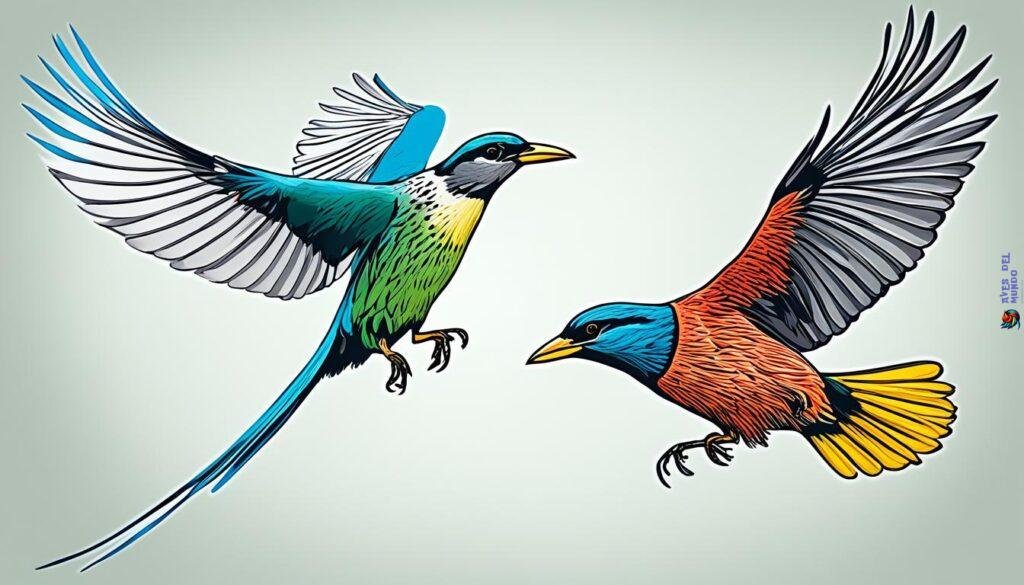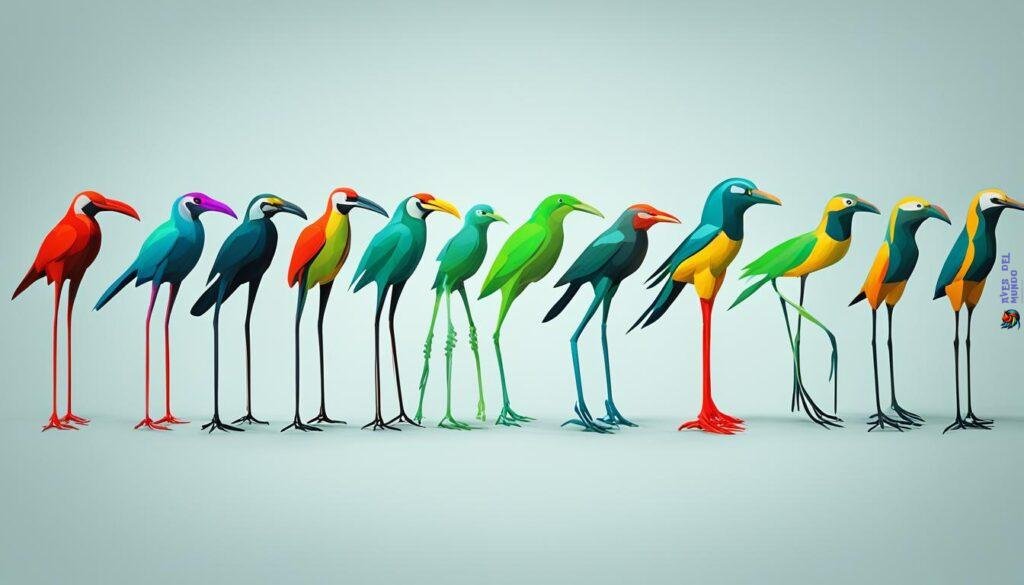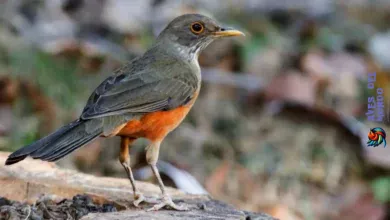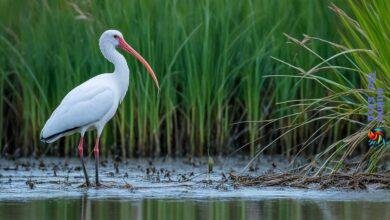Think about this: people walk about 7,000 steps a day. Birds, though, can travel similar distances with legs as thin as pencils. The slender legs of birds are not just for looks. They are key for survival. In the bird world, thin legs allow them to move in amazing ways. These adaptions let birds thrive in all sorts of places, from wet marshes to tall trees. Let’s explore how birds use their thin legs to move and live in different environments.
Bird movement has been a mystery to scientists for a long time. Take the flamingo’s elegant walk or a sparrow’s quick hop. These movements tell stories of how they’ve adapted to survive. By looking at how birds’ legs are designed, we see why they excel in the air and on the ground. Their legs are a big reason why birds are so good at living in many places.
Understanding Bird Anatomy and Adaptations
Exploring bird anatomy opens up a world of wonder. We see the height of adaptation in the bird world. Think of the Arctic tern’s incredible journey or a hummingbird’s skillful hover.
Birds share a need for efficiency and survival through unique traits. Their skeletons are engineering feats, strong yet light for flying. This is because their bones are fused and hollow, perfectly balancing strength and lightness.
Feathers do more than just help with flight and warmth. They also waterproof, enable silent flying, and have colors for camouflage, mate attraction, and communication. They’re key to surviving the wild.
The beaks of birds show astonishing variety, each shaped by diet, highlighting survival tools. From flesh-tearing sharp hooks to the flamingo’s filtering beak, each is tailored for thriving in specific environments.
Leg structures in birds also adapt to their living conditions. Some birds climb with clawed feet; others swim with webbed toes. These adaptations show how birds have evolved to live in diverse places.
Consider the table below as a glimpse into this incredible diversity:
| Species | Beak Type | Diet | Leg Type | Habitat Adaptation |
|---|---|---|---|---|
| Bald Eagle | Hooked | Carnivorous | Powerful, with talons | Open waters and forests |
| Flamingo | Filter-feeder | Omnivorous, algae, and small animals | Long, stilt-like | Shallow lakes and lagoons |
| Woodpecker | Strong, chisel-like | Insectivorous | Zygodactyl feet | Woodland and forest areas |

Over millions of years, birds have become experts at adaptation. Their bird anatomy has evolved for survival. We now see the results of nature’s experiments—a perfect mix of form and function in birds.
The Function and Diversity of Bird Beaks
Have you ever wondered at how different bird beaks are? They show how birds have adapted to survive. Their beaks help them eat and are crucial for living. This matches well with how they move in water or grab their prey.

This shows us how birds use their beaks and legs together. They do this to live well in many places.
Specialized Bills: From Seed-Eating to Prey-Tearing
Finches and sparrows have beaks made for cracking seeds. This shape is perfect for these types of birds. On the other hand, raptors have sharp claws and beaks for hunting. Their bodies are made to be really good at catching prey.
The Adaptive Significance of Beak Shapes Across Species
Beaks can look very different, like the thin ones of nectar feeders or the big ones of pelicans. Shorebirds have long legs to eat in shallow water, and ducks have strong legs and big beaks to find food underwater. These shapes are all because of natural selection, helping each bird be its best.
The Importance of Thin Legs in Birds
When exploring the world of birds, one striking feature stands out: their thin legs. What’s the reason behind this, and how does it help them survive? The answer lies in avian locomotion. Birds that have long, slender legs are skilled at moving around. They’re especially good at wading in water. Imagine seeing a bird move with the grace of a stilt-walker. That’s what these birds do, but naturally.
Their legs are shaped to cut through water easily. This shape is key for wading birds. It lets them move through water quickly without making much noise. This way, they can sneak up on their prey. The way a bird’s legs work isn’t just about moving better. It’s also about surviving and being efficient hunters in their own worlds.

These legs show how well birds can adapt. The importance of thin legs in birds is huge for saving energy. Having less weight to carry means they use less energy. This helps them be more active, whether they’re flying or looking for food on the ground. Thin legs are great for many different situations.
| Bird Feature | Function | Adaptive Advantage |
|---|---|---|
| Thin, elongated legs | Stable, low-impact wading through water | Stealth during aquatic predation |
| Lightweight, slender limbs | Reduced energy expenditure | Endurance in long-duration activities |
| Scaled feet with spread toes | Enhanced grip and balance | Agility and stabilization on varying surfaces |
So, whenever you see a bird gracefully moving, pause to admire it. Those thin legs are a result of evolution making them precise tools. In the story of avian locomotion, every leg plays a key role. It’s all for the survival of these amazing animals.
Avian Locomotion: The Role of Leg Structure in Birds
Exploring bird physiology shows us how avian locomotion varies widely. The leg structure in birds showcases evolution’s work, aiding their movement in air and on ground. Notice how each bird’s legs are shaped by their living space, when you’re bird watching or studying their behaviors.
Looking at leg structure in birds shows us why they move so well. For example, a heron’s thin legs show it’s a master at quiet water hunting. Every bird species has legs designed for survival, whether that means long legs for wading or webbed feet for swimming.
| Bird Type | Leg Structure | Locomotion Adaptation |
|---|---|---|
| Wading Birds (e.g., Storks) | Long, thin legs with spread toes | Stability in water, efficient hunting in shallow depths |
| Ground Birds (e.g., Roadrunners) | Strong, muscular legs for running | Rapid terrestrial movement to evade predators and chase prey |
| Tree-Dwelling Birds (e.g., Woodpeckers) | Zygodactyl feet with sharp claws | Enhanced grip for vertical movement and foraging on bark |
| Raptors (e.g., Eagles) | Powerful legs with talons | Forceful grip for catching and subduing prey |
| Swimming Birds (e.g., Ducks) | Webbed feet for propulsion in water | Efficient aquatic locomotion and foraging |
Energy expenditure varies with different avian locomotion methods. Birds like the ostrich are great at long walks, thanks to their endurance-ready leg muscles. On the other hand, birds that jump between trees need short burst muscles for quick moves.
When looking at bird physiology, it’s fascinating to see how leg structures influence social habits. Birds that move in flocks have synchronized movements, made possible by their similarly designed legs.
Watching flamingos move together shows that avian locomotion is almost like a group dance. This «dance» is shaped by eons of evolution.
Legs also help birds with defense strategies, like when small birds team up against predators. Their agility and speed, thanks to their legs, are vital here.

In reflecting on bird physiology, consider the resilience of these creatures. From bones to feathers, their legs have been crafted by nature to support survival. This highlights their adaptability, balancing flight and grounded mobility.
Evolutionary Significance of Bird Legs
The amazing variety of birds partly comes from the evolutionary significance of bird legs. These legs have changed to suit different places. As you look at the places birds live, you see their legs are just right for their lives there. This has been key for their survival and having offspring.

Let’s dig deeper into how changing to fit their environments affected how bird legs work. You can see this in what birds do every day.
From Wading to Climbing: How Birds Use Their Legs
Look at flamingos. Their long legs let them walk into water to eat while staying dry. Then there’s the woodpecker. Its short legs with strong toes help it hold onto trees. These examples show how bird legs change based on where they live.
Adaptation to Environments: The Evolution of Bird Leg Function
Birds use their legs in many ways, showing how evolution has shaped them. The Brolga dances, showing off its legs for mates. The Montezuma Oropendola builds hanging nests with its legs. So, bird legs do a lot more than just walk.
| Bird Species | Leg Type | Primary Function | Environment |
|---|---|---|---|
| Flamingo | Long, thin | Wading in water | Shallow lakes |
| Woodpecker | Zygodactylous | Climbing tree trunks | Woodlands |
| Peregrine Falcon | Powerful with sharp talons | Grasping prey during flight | Open skies, cliffs |
| Red Knot | Short, sturdy | Foraging on mudflats | Coastal areas |
The link between a bird’s leg type and their survival is clear. Whether they’re in wetlands or on trees, their legs help them face their world’s challenges.
The Interplay of Bird Physiology and Survival Techniques
The way birds are built plays a big role in how they live each day. It’s important to see how bird body characteristics help them adapt. This helps us marvel at the wonders of birds.
Birds have special body features that help them meet the demands of living. Their four-chambered heart is perfect for a life on the wing. But it’s not just what’s inside that counts. The outside features, like their legs, are just as important. They help birds feed, avoid predators, and stay the right temperature in different climates.
Birds have survival techniques that tell us a lot about how they act and react to their world. Keeping warm by fluffing their feathers is one way they deal with cold. This, among other adaptations, shows how important their unique body structure is for surviving.

| Physiological Feature | Survival Function | Examples |
|---|---|---|
| Four-chambered heart | Efficient circulation supports sustained flight | Eagles, Hummingbirds |
| High metabolic rate | Provides energy for flight and rapid response | Falcons, Sparrows |
| Leg features | Adapted for specific tasks like capturing prey or wading | Herons (wading), Hawks (gripping) |
| Feathers for thermoregulation | Fluffing to retain heat and streamline for aerodynamics | Penguins (warmth), Swifts (aerodynamics) |
Exploring the world of birds, we see that every survival technique comes from years of evolution. The bird physiology we find fascinating is closely linked with their survival. It allows them to thrive and carry on their legacy.
Differentiating Bird Species Through Leg Characteristics
Understanding leg morphology is key for bird lovers. It helps in differentiating bird species. Whether a newbie or an expert in birdwatching, noticing leg details can make you appreciate birds more. It shows how each species is unique and how they’ve evolved.
Leg Morphology in Identifying and Classifying Birds
Leg types are crucial for identifying and cataloging birds. Take the strong legs of a roadrunner versus the long legs of a flamingo. Such differences reflect how birds have adapted to their surroundings over time.

Role of Leg Adaptations in Bird Speciation and Niche Fulfillment
Leg changes have been pivotal in birds evolving into new species. From the sharp talons of an eagle to the webbed feet of a duck, these features show how birds have adapted. This specialization helps them survive and reproduce in their specific niches.
| Bird Species | Leg Characteristics | Ecological Niche |
|---|---|---|
| Heron | Long, thin legs | Wetlands, shallow water fishing |
| Woodpecker | Strong legs with gripping toes | Tree climbing, bark foraging |
| Ostrich | Powerful, muscular legs | Open savannah, running |
| Penguin | Short, webbed feet | Cold environments, swimming |
Studying leg morphology in birds reveals much about their lives. It shows how birds have perfectly adapted to their worlds. These leg adaptations highlight the beauty and cleverness of bird design. They’re proof of the marvels of evolution.
How Bird Leg Function Facilitates Mating and Breeding Behaviors
In the intricate world of birds, bird leg function is crucial for mating and breeding behaviors. Look at the cranes’ dances, for example. Their long, sturdy legs help them maintain balance and move gracefully during courtship. These legs showcase their strength and are key to bird adaptations for breeding success.

Bird legs are also important for building and taking care of nests. Whether it’s nests in treetops or on the ground, bird legs are versatile. They show dexterity and stability, vital for these tasks.
| Bird Species | Leg Features | Mating Display Function | Nesting Behavior |
|---|---|---|---|
| Flamingos | Long, stilt-like | Marching in synchronized groups | Mud mound construction with feet |
| Bowerbirds | Robust | Building and decorating intricate bowers | Ground nest assembly |
| Peacocks | Strong, supportive | Fanning out spectacular tail feathers | Ground nesting, with legs serving as support during displays |
| Penguins | Short, strong | Stone offering and vocalizations | Inclined posture for egg incubation on feet |
Defending territory is another area where legs are vital. Consider the ostrich’s kicks. They keep predators away and are part of courtship. This shows the wide impact of bird adaptations on survival and species continuation.
During incubation swaps, the precision of leg use is noticeable. A steady grip and precise positioning help keep the eggs warm. This careful management ensures that chicks hatch successfully.
Watching these activities, it’s clear: their legs are not just for movement. They are essential for the dance of life, aligning with survival and continuation.
Comparative Analysis of Bird Leg Types Across Habitats
Exploring bird species legs reveals a world of unique adaptations. Birds have developed a wide range of bird leg functions to survive on land and in water. Each species’ leg type precisely matches their lifestyle and habitat needs.
Ducks’ webbed feet are perfect for swimming, while woodpeckers use sharp claws to grip bark. This comparative analysis of bird leg types showcases the evolutionary ingenuity behind these adaptations. They help birds survive daily.
Adaptations for Aquatic versus Terrestrial Lifestyles
In ponds and streams, birds like swans and kingfishers display specialized aquatic adaptations. Their webbed and lobate toes allow them to maneuver and propel in water. This is crucial for hunting and escaping predators.
On the other hand, land birds have strong, clawed feet. These are used for digging, running, and even handling objects. It shows the wide range of bird leg function in different environments.
Leg Design: Flight, Foraging, and Flocking Impact
Leg design affects ground and water activities, flight, foraging, and flocking. From eagles with strong talons for hunting to hummingbirds with lightweight legs for flight. This highlights how vital leg type is in birds’ survival strategies.

| Aquatic Bird Species | Terrestrial Bird Species | Flying Bird Species |
|---|---|---|
| Ducks: Webbed feet for swimming | Ostriches: Powerful, muscular legs for running | Falcons: Compact legs for dynamic diving |
| Pelicans: Long legs for wading and scooping fish | Grouse: Feathered legs for warmth and camouflage | Albatross: Long, slender legs for wind-assisted takeoff |
| Flamingos: Stilt-like legs for wading in deep water | Woodpeckers: Zygodactyl feet for climbing | Hummingbirds: Lightweight legs for agility in flight |
Studying these birds reveals the link between form and function. The comparative analysis of bird leg types highlights adaptation’s beauty. Bird species legs support their diverse lifestyles—wading, running, or flying. These adaptations ensure their success worldwide.
Nesting and Incubation: Bird Leg Use During Reproduction

As we dive into the world of birds, it’s key to look at how nesting and incubation fit into their lives. The design of a bird’s legs, a critical bird adaptation, plays a major role during the breeding season. Beyond walking, their legs serve many purposes. These include helping in nesting strategies and warming up their eggs.
Diverse Nesting Strategies and Leg Utility
Different birds use their legs in unique ways for nesting. Albatrosses build simple nests on the ground. They use their strong legs to gather materials and make a cozy spot for their babies. On the other hand, great egrets create nests on reeds. Their long legs help them keep the nest steady. Here’s a look at how nesting differs among birds:
| Species | Nest Type | Leg Function |
|---|---|---|
| Albatross | Ground, scrape-type | Material collection and nest assembly |
| Great Egret | Tree, platform-type | Balance and strength for nest support |
| Flamingo | Ground, mound-type | Elevation from wet soils |
Incubation Duties and the Importance of Claws and Leg Position
The job of incubation starts once the nest is ready. Now, the bird’s legs and claws show their true importance. In birds that lay many eggs, like the American avocet, legs help in keeping the eggs warm evenly. Claws are vital too. They gently turn the eggs. This is to make sure all eggs develop well.
- Flamingos stand on their mound nests. Their webbed feet keep the eggs at the right temperature.
- Ostriches use their powerful legs to press down the nest’s surface. This makes a safe place for their big eggs.
- Penguins, who must stay standing to incubate, have special leg features to keep warm.
Looking at these examples shows us that bird legs are shaped not just for moving around. They have evolved in complex ways because of the need to reproduce. This shows the intricate beauty in how birds are made.
Feather Functionality and How It Complements Leg Use
Exploring bird body features shows how feathers and legs work together perfectly. Feathers aren’t just pretty. They help birds survive and find mates. They let birds from hawks to peacocks do everything from flying to showing off.
Feathers play a big part in how birds move. They work with the legs for smooth movements, like gliding or changing direction quickly. During courtship, bright feathers and strong legs help attract mates. This shows how important both features are for birds.
Feathers and legs have evolved together, making birds’ daily tasks possible. Whether it’s an owl hunting quietly or a hummingbird flashing its colors, their design works well. This perfect match helps them succeed in their environments.



